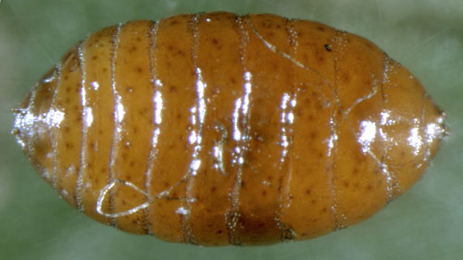|
||||||
| Agromyza
anthracina Meigen, 1830 [Diptera: Agromyzidae] |
||||||||||||||||||||||||||||||||||||||||||||||||||||||||||||||||||||||||||||||||||||||||||||||||||||||||||
|
Agromyza
anthracina
Meigen, 1830. Syst. Beschr. 6: 173 |
||||||||||||||||||||||||||||||||||||||||||||||||||||||||||||||||||||||||||||||||||||||||||||||||||||||||||
Larva: The larvae of flies are leg-less maggots without a head capsule (see examples). They never have thoracic or abdominal legs. They do not have chewing mouthparts, although they do have a characteristic cephalo-pharyngeal skeleton (see examples), usually visible internally through the body wall. The larva is described by Dempewolf (2001) and illustrated in Bladmineerders van Europa. Mandibles with three teeth (Bladmineerders van Europa); posterior spiracles each with 3 bulbs on a conspicuous protuberance (Spencer, 1972b: 39). Puparium: The puparia of flies are formed within the hardened last larval skin or puparium and as a result sheaths enclosing head appendages, wings and legs are not visible externally (see examples). The puparium is illustrated in Bladmineerders van Europa.
Hosts in Great Britain and Ireland:
Hosts elsewhere:
Time of year - mines: June-July, October-November. Time of year - adults: July-August. Distribution
in Great Britain and Ireland: Widespread, but local. including
London (Hampstead), Surrey (Godalming), Cambridge (Chippenham Fen),
Dorset (West Bay), Dunbartonshire (Bonhill), Sutherland (Golspie) (Spencer, 1972b: 39); Inner Hebrides (Isle of Coll, Arinagour) (Bland,
1992), Warwickshire (Print Wood) (Robbins,
1991: 71), Hampshire (Fleet) (British
leafminers), Caernarvonshire, Cambridgeshire, Carmarthenshire, Denbighshire, East Gloucestershire, East Ross, East Suffolk, Easterness, Edinburgh, Leicestershire, Main Argyll, Merionethshire, North Hampshire, North Somerset, Orkney, Shropshire, South Hampshire, South Lancashire, South-east Yorkshire, South-west Yorkshire,
Stafford, Surrey, West Kent, Westmorland and Worcestershire (NBN
Atlas). Also recorded in the Republic of Ireland (Fauna Europaea) and National Biodiversity Data Centre Map). Distribution elsewhere: Widespread in continental Europe including Denmark, Finland, Norway and Sweden (Spencer, 1976: 99), The Netherlands (Bladmineerders van Europa), Belgium (Scheirs, de Bruyn and von Tschirnhaus, 1996), Germany (Spencer, 1976: 546; Dempewolf (2001), Czech Republic, French mainland, Hungary, Lithuania, Poland, Slovakia and Switzerland (Fauna Europaea). NBN Atlas links to known host species:
British and Irish Parasitoids in Britain and elsewhere:
|
||||||||||||||||||||||||||||||||||||||||||||||||||||||||||||||||||||||||||||||||||||||||||||||||||||||||||
| Last updated 07-Oct-2019 Brian Pitkin | ||

